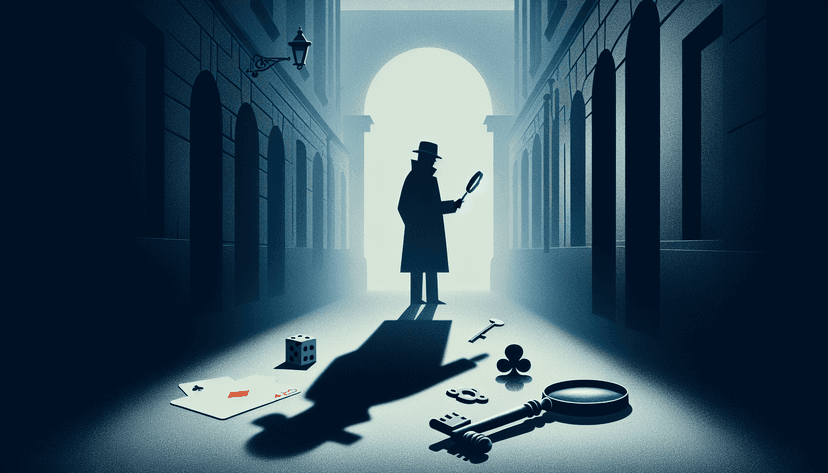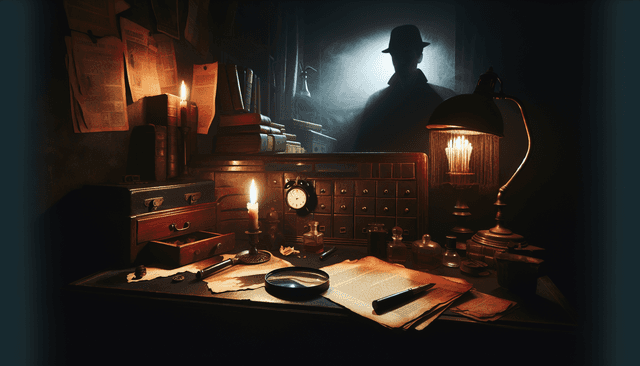Table of Contents
Coming up with a murder mystery idea can feel like searching for a needle in a haystack. Whether you’re planning a party, writing a story, or just looking for some inspiration, it’s easy to feel stuck. After all, we all want our plot twists and clues to be as gripping as a page-turner novel, right?
But don’t worry! If you stick around, you’ll discover a treasure trove of compelling ideas that will spark your creativity and have you plotting your next great tale in no time. From classic scenarios to unique characters, I promise you’ll find something that tickles your fancy.
In this guide, we’ll explore various themes, settings, and character ideas, plus tips for crafting that perfect suspense-filled narrative. Get ready to dive into the world of murder mysteries, where every twist could lead to an unforgettable story!
Key Takeaways
- Classic murder mystery setups include a locked room, a gala event, or an eccentric family, providing a solid base for unique plots.
- Innovative settings like a spaceship or a quirky town festival can heighten tension and intrigue.
- Develop complex characters with motives and flaws to engage readers and keep them guessing.
- Incorporate unexpected twists, such as an unreliable narrator or role reversals, to maintain suspense.
- Ground your story in reality by drawing inspiration from real-life events, ensuring sensitivity and respect.
- When planning a murder mystery game, choose an exciting theme, create backstories, and establish clear rules for player interaction.

Murder Mystery Ideas You Can Use
Murder mystery stories can be thrilling, engaging, and full of twists that keep readers on the edge of their seats. Whether you’re writing a novel, crafting a short story, or planning a murder mystery game night, having a great premise is key. This article will explore some classic scenarios, unique settings, and engaging characters to inspire your next mystery.
Classic Murder Mystery Scenarios
When it comes to crafting a murder mystery, classic scenarios never go out of style. Think of settings like a quaint manor house filled with eccentric relatives who all have motives. A locked room mystery can add to the suspense, as it challenges both characters and readers to figure out how the crime was committed.
Another classic is the whodunit at a gala event, where all the guests are suspects. This scenario allows you to create a diverse cast of characters, each with their own secrets and potential motives. For instance, the jilted lover, the jealous spouse, or the greedy business partner can provide compelling subplots and red herrings.
Consider incorporating a twist where the victim isn’t who they seem. Maybe they’re involved in a dark conspiracy, and their death uncovers secrets within the community. Using tried-and-true setups can provide a solid foundation, but remember to add your unique spin.
Unique Settings for Your Murder Mystery
If classic settings feel too familiar, think outside the box. Imagine a murder set in a futuristic spaceship where every crew member is a potential suspect. The contained environment heightens tension, and the absence of external help increases urgency.
Another intriguing setting could be in a quirky town known for its bizarre annual festivals. Perhaps the murder occurs during the town’s famous “Ghost Parade,” where all the locals wear masks and costumes. This anonymity can create layers of intrigue, as identities become obscured.
Don’t overlook the natural world either. Picture a secluded cabin in the woods where a group of friends gathers for a weekend getaway. As the night unfolds, secrets surface, and the isolation creates a deadly atmosphere. Using locations that enhance the mood of your mystery can significantly impact your story.
Engaging Characters for Your Mystery Story
The heart of any good murder mystery lies in its characters. You want your readers to connect with them, whether they love them or hate them. Start with a charismatic detective who has a knack for observation. This character can provide comic relief while also carrying the story forward.
Include a mix of supporting characters, such as the enigmatic stranger who knows too much, or the local who seems too eager to help. Creating characters with well-defined flaws and backgrounds can add depth and make them feel more realistic. Maybe your red herring is the shy librarian with a secret past.
It’s also effective to give characters conflicting motives. This will keep readers guessing about who the real culprit might be. Complexity in your characters not only advances the plot but also enrichens the reader’s experience. For inspiration, you can look into character-building resources like static vs dynamic character differences.

Twists and Turns to Add Suspense
Incorporating unexpected twists into your murder mystery keeps readers engaged and guessing until the final reveal. Start with subtle clues that mislead readers while still making sense in retrospect.
One common twist is the idea of an unreliable narrator. This character can distort the truth about the events or their involvement, leaving readers questioning everything they thought they knew.
Another effective twist involves the role reversal of suspects. Initially, it may appear that the detective is the one in control, only for them to become a suspect themselves, raising the stakes.
Think about using the classic “it was the least likely character” twist. Perhaps a passive character suddenly reveals a dark side, surprising both the readers and other characters.
When mastering suspense, pacing is essential. Sprinkle clues throughout the story, creating a slow-build tension rather than revealing everything at once. This approach can amplify the impact of your twists and keep readers on their toes.
Incorporating Real-Life Events into Your Mystery
Using real-life events in your murder mystery can ground your story in reality and make it resonate more with readers. Start by researching notable events that could act as inspiration, such as historical murders or unsolved cases.
For instance, imagine developing a fictional plot around a scandal that mirrors real-life defamation or betrayal. This adds an element of truth that readers can relate to, creating a compelling narrative.
Also, consider how you can weave current issues into your mystery. Topics like political corruption, social justice, or environmental crises can enhance the plot’s relevancy and add layers of complexity.
However, be mindful about how you depict sensitive events. It’s essential to approach these subjects respectfully, avoiding trivialization of real pain or suffering.
Engaging with readers through familiar historical context or cultural references can enhance immersion in your story. You might even encourage them to think critically about the past’s impact on the present.
Creating a Murder Mystery Game
Designing a murder mystery game can be a fun and interactive way to engage friends, family, or even coworkers. Start by picking a theme that excites your audience—think classic detective fiction or a quirky 1920s speakeasy.
Next, create the storyline. Outline the crime, the characters, and their motivations. Develop intriguing backgrounds for each suspect to help players immerse themselves in their roles.
Consider constructing a set of clues that players must gather and analyze. These can be physical items, written notes, or even digital clues if you’re hosting the game online.
Be sure to establish rules for gameplay. Decide how players will interact with each other: will they work in teams, or will it be more competitive? Clarifying these elements can enhance the experience.
Finally, set the mood with decorations, music, and possibly costumes—all of which can heighten the atmosphere and make your mystery night unforgettable. If you want to dive deeper into how to make such a game appealing, you can check out tips for engaging interactive storytelling.

Tips for Writing a Compelling Murder Mystery
To write a compelling murder mystery, start with a strong premise that grabs attention right away. Ensure your plot has a clear structure, with a beginning that hooks the reader, a middle filled with twists, and a satisfying conclusion.
It helps to create an outline detailing major plot points and character arcs, so you always know where the story is heading. As you write, be mindful of pacing; a mix of fast-paced action and slower, more reflective moments can keep readers engaged.
Don’t shy away from foreshadowing key elements early on. This will make the final reveal more satisfying and allow readers to piece together clues as they go. Also, consider writing from multiple perspectives to give readers varied insights into the motives and actions of each character.
Lastly, when in doubt, revise your work. Editing is where you’ll polish your story and ensure that every plot twist and character interaction is as tight as it can be.
Popular Themes for Murder Mystery Parties
Themes can elevate a murder mystery party from ordinary to unforgettable. Classic themes like “Masquerade Ball,” where guests wear masks and costumes, instantly add a layer of intrigue.
Another entertaining theme could be “Hollywood Whodunit,” with guests acting as celebrities in a glitzy awards show atmosphere. Include nods to famous films and stars to engage your attendees further.
Then you have the “Murder on the Orient Express,” where guests play characters aboard a train, facing off against a murder that gets everyone involved. The confined spaces and unique setting lend an exciting flair to the mystery.
Don’t forget about modern themes as well! A “Tech Gone Wrong” scenario, with a murder happening during a virtual meeting, allows for creativity while touching on contemporary issues. Ultimately, choose a theme that resonates with your group—it’ll set the tone for a memorable night.
How to Plan a Murder Mystery Night
Planning a murder mystery night involves several key steps that will make your event flow smoothly. Start by deciding on a date, time, and location.
Next, choose a theme that suits your audience, whether it’s a classic dinner party or a more casual gathering. Once your theme is set, select a murder mystery kit or create your own storyline, which includes characters and plots tailored to your guests.
Send out invitations that contain the necessary details and a brief character description, allowing guests to arrive in costume if they wish. On the day of the event, prepare the space by arranging seating and decorations to match your chosen theme.
Lastly, plan for food and drinks—snacks that don’t take too much attention away from the game, yet allow for mingling. With everything in place, guide your guests through the game, encouraging discussion and sleuthing among them.
Resources for Developing Your Mystery Ideas
Developing fresh ideas for your murder mystery can be fun with the right resources at hand. Start with books on mystery writing, like “Writing Mysteries” by Sue Grafton, which can provide insights into crafting plots and characters.
Online platforms like Pinterest are gold mines for inspiration, offering boards dedicated to murder mystery themes, scenes, and character-building ideas.
Joining writing forums or communities can also introduce you to fellow mystery enthusiasts. They often share tips, prompts, and feedback on your ideas.
Lastly, consider attending or participating in a murder mystery workshop. These can provide hands-on experience and help ignite your creativity, ensuring you have plenty of ideas to work with for your next project.
FAQs
Classic scenarios include a locked room mystery, a dinner party gone wrong, a murder in a small village, or a crime at a glamorous ball. Each creates a captivating backdrop for plotting twists and engaging characters.
To create a murder mystery game, develop intriguing characters, establish a clear plot with a twist, and set engaging locations. Include clues and challenges that encourage participant interaction for a thrilling experience.
Popular themes include the Roaring Twenties, Hollywood Glamour, and a Masquerade Ball. These themes elevate the experience by enhancing the setting and costumes, making the party more immersive and engaging.
Start with a strong premise, develop well-rounded characters, and maintain suspense with red herrings. Ensure a logical plot progression and an unexpected twist, leading to a satisfying resolution for readers or players.



